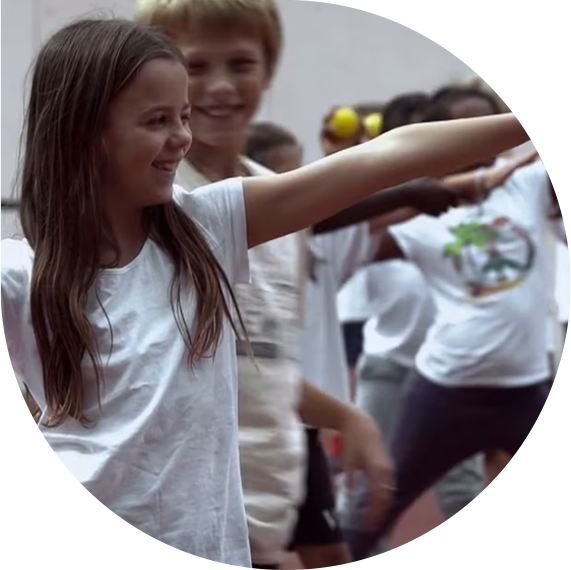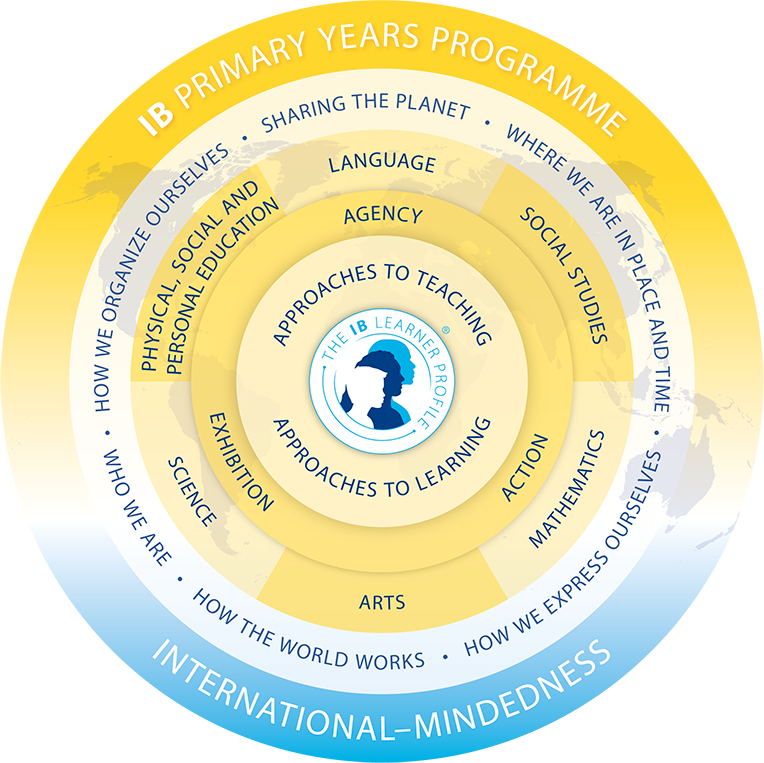Through engaging Units of Inquiry, students discover the world around them and develop key skills and understandings in mathematics and literacy. Visual Arts, Music, Physical Education, and Foreign languages are taught by specialists outside of the homeroom.

Learning Programme
The IB Primary Years Programme (PYP)
The PYP curriculum framework begins with the premise that students are agents of their own learning and partners in the learning process. It prioritizes people and their relationships to build a strong learning community.
PYP students use their initiative to take responsibility and ownership of their learning. By learning through inquiry and reflecting on their own learning, PYP students develop knowledge, conceptual understandings, skills and the attributes of the IB Learner Profile to make a difference in their own lives, their communities, and beyond.

Sample Schedule
The Primary Years curriculum promotes the idea that students and teachers are partners in the learning process of discovery, connection and achievement. Students are led to become active agents of their own learning, and in collaboration with others.
Inquiry-based learning encourages students and teachers to grapple with conceptual understandings, to reflect on their work and develop their skills and the attributes of the IB Learner profile.
A typical day at TOIS Primary might look like this:
- 8:20 Arrival at School
- 8:30 Period 1
- 9:15 Break 1
- 9:25 Period 2
- 10:10 Break 2
- 10:30 Period 3
- 11:15 Lunch and Recess
- 12:15 Period 4
- 13:00 Break 4
- 13:05 Period 5
- 13:50 Break 5
- 14:00 Period 6
- 14:45 End of Day
- 15:00 Clubs
Units of Inquiry
A Unit of Inquiry is a 6-8 week in-depth exploration of a concept. Students inquire into a central idea or a main understanding by being guided through lines of inquiry and teacher questions.
| PYP 1 Units of Inquiry |
|
| PYP 2 Units of Inquiry |
|
| PYP 3 Units of Inquiry |
|
| PYP 4 Units of Inquiry |
|
| PYP 5 Units of Inquiry |
|
Mathematics
Mathematics at TOIS is looked at as a way of thinking, a tool for solving problems, and support for inquiry. TOIS Maths program leads young learners to use patterns, models, facts but furthermore, it encourages them to make their own idea to solve a problem situation and evaluate it and explain the way of thinking. While applying their mathematical reasoning to solve a real-life problem students investigate, research, discuss and justify. The whole program builds a foundation for later study of algebra. Whenever possible, the Mathematics is taught in the context of the units of inquiry.
- authentic, real-life problems
- investigation and exploration (inquiry)
- purpose and WHY
- problem solving skills
| PYP 1 Maths Focus |
|
| PYP 2 Maths Focus |
|
| PYP 3 Maths Focus |
|
| PYP 4 Maths Focus |
|
| PYP 5 Maths Focus |
|
English Language and Literacy
The Primary Language & Literacy program provides an intellectual framework to support conceptual development and critical thinking while enriching students in intercultural awareness and international mindedness.
Moving beyond the four language skills of reading, listeninng, speaking and writing, students develop clarifying ideas, apply relevant information from text, get life-long reading habits, and the skill to interpet data from various visual texts. Students develop their skills as speakers and as a listeners.
| PYP 1 English Language and Literacy |
|
| PYP 2 English Language and Literacy |
|
| PYP 3 English Language and Literacy |
|
| PYP 4 English Language and Literacy |
|
| PYP 5 English Language and Literacy |
|
Additional Languages and Czech for Natives
Children develop language skills and at the same time deepen intercultural understanding, learn about the differences in the way of life of people from other countries and their different cultural traditions. The program helps create preconditions for effective interpersonal communication, either oral or written. It develops strategic skills: formulate ideas orally and in writing, understand spoken and written language.
| Native Czech Students | To support Czech parents and students with the compulsory education, students from PYP1 to PYP 5 have Czech for Native lessons for 45 minutes, four times a week. The final examination is conducted in cooperation with a public school in nearby Ludgeřovice. |
| Non-Czech Students | Non-Czech students study Czech for foreigners and Spanish as additional languages, each for 45 minutes two times a week. |
Personal, Social and Physical Education
This program focuses on the physical, intellectual, emotional and social development of each child. Learners are encouraged to make choices that contribute to long-term healthy living.
Well-being is supported through three interactive strands:
- Identity: developing an understanding of one’s own beliefs and values, in order to successfully cope with situations of change
- Active living: understanding the attributes of a balanced, healthy lifestyle, the body’s potential for movement and expression, prevention of illness, making healthy choices, and evaluating consequences
- Interactions: appreciating the environment
| Physical Education | Personal and Social Education | |
| PYP 1 Personal, Social and Physical Education |
|
|
| PYP 2 Personal, Social and Physical Education |
|
|
| PYP 3 Personal, Social and Physical Education |
|
|
| PYP 4 Personal, Social and Physical Education |
|
|
| PYP 5 Personal, Social and Physical Education |
|
|
PYP 1 to PYP 5 students participate in PSPE lessons twice a week for 45 minutes. Lessons take place in the gym or outside.
Music
Guides the student through vocal, instrumental, musical movement and listening activities to understand the art of music, to actively perceive music and singing and their use as an independent means of communication. There is a strong emphasis on creative process and exploration of music in connection with individual interest and focus.
The program reflects the strands of performance, music literacy, improvising and creating, instrumentation and appreciation.
| PYP 1 Music |
|
| PYP 2 Music |
|
| PYP 3 Music |
|
| PYP 4 Music |
|
| PYP 5 Music |
|
PYP 1 to PYP 5 students participate in Music lessons twice a week for 45 minutes. Lessons take place in the Music Room.
Visual Arts
Art education is based on creative activities – creation, perception and interpretation. These activities make it possible to develop and apply one’s own perception, feeling, imagination, fantasy, and invention. Students work not only with traditional and verified visual images, but also newly emerging in the current fine arts and visual media. Creative activities are based on experimentation, which leads students to the courage and desire to personally apply unique feelings and experiences and to engage in the process of creation and communication at their appropriate level.
At the same time visual art gives students opportunities to experience, broaden, deepen their knowledge and skills gained in the units of inquiry.
| PYP 1 Visual Arts |
|
| PYP 2 Visual Arts |
|
| PYP 3 Visual Arts |
|
| PYP 4 Visual Arts |
|
| PYP 5 Visual Arts |
|
PYP 1 to PYP 5 students participate in Visual Art lessons once a week for 90 minutes (block lessons). Lessons take place in the Art Room.
Learning Support Services
EAL - English as an Additional Language
Many students who join TOIS speak little or no English. Our English as an Additional Language (EAL) Programme helps students new to the English language become confident and proficient users of the language, with the aim of supporting academic progress and integrating students into the daily social life of the school as quickly as possible. EAL specialists and teachers work closely together to support language development of EAL students, focusing on cultivating the four language strands of reading, writing, speaking and listening.
Student Well-Being
Student well-being is an absolute priority. Learners are supported when adapting to a new class environment. The SWB Coordinator and Special Educational Needs (SEN) specialists provide pedagogical counselling if needed and perform screening and diagnostics of specific learning disabilities. A team is created of the student, parents and teachers to support and maximise potential.
Library
Students from PYP1 to PYP5 participate in the Library Lessons once a week, for 45 minutes. The lessons take place in the Primary Library.
LIbrary lessons are focused on:
- mother tongue support with multilingual resources
- fostering passion for reading, research and inquiry
- development of information literacy
- utilising library as a resource centre
PYP Librarian supports homeroom teachers in tracking student reading progress using PM Benchmark kit, twice a year.
ICT
As ICT is taking an increasingly more important role in the world, it is an integral part of teaching and learning at our school as well. It is used purposefully and meangingfully across all subjects, enhancing inquiry, student cooperation and organisation. At the same time, the students are taking first steps in becoming responsible and knowledgeable digital citizens with the support of our ICT curriculum.
Discover
The PYP focuses on the development of the whole child, and encourages students to find out about themselves and the world around them. PYP Units of Inquiry allow learners to make connections on an intellectual, emotional, social and physical level.
Connect
Inquiry-based learning leads young people to think about big ideas, to ask questions, and think critically and reflectively. Students make meaningful connections through authentic learning, and at the same time, meet specific curricular standards.
Achieve
Students have many different ways to experience a sense of accomplishment, whether in Mathematics and Literacy, in the Sciences, the Arts, Physical Education, Foreign Languages, special school events, or extra-curricular clubs.